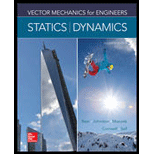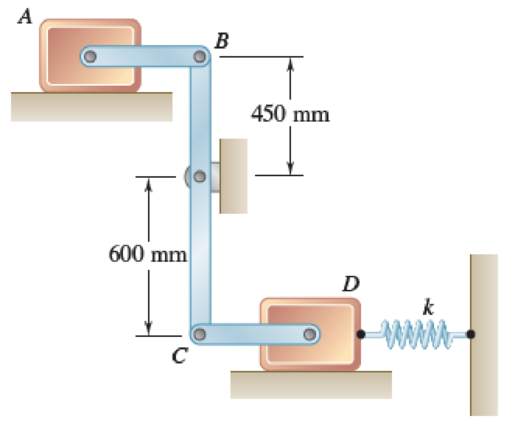
Vector Mechanics for Engineers: Statics and Dynamics
11th Edition
ISBN: 9780073398242
Author: Ferdinand P. Beer, E. Russell Johnston Jr., David Mazurek, Phillip J. Cornwell, Brian Self
Publisher: McGraw-Hill Education
expand_more
expand_more
format_list_bulleted
Concept explainers
Textbook Question
Chapter 19.3, Problem 19.69P
Two blocks each have a mass 1.5 kg and are attached to links that are pin-connected to bar BC as shown. The masses of the links and bar are negligible, and the blocks can slide without friction. Block D is attached to a spring of constant k = 720 N/m. Knowing that block A is at rest when it is struck horizontally with a mallet and given an initial velocity of 250 mm/s, determine the magnitude of the maximum displacement of block D during the resulting motion.

Expert Solution & Answer
Want to see the full answer?
Check out a sample textbook solution
Students have asked these similar questions
using the theorem of three moments, find all the moments, I need concise calculations only
Practise question need help on
Can you show explaination and working. The answer from the text book is Q=5.03 X 10^-3
Chapter 19 Solutions
Vector Mechanics for Engineers: Statics and Dynamics
Ch. 19.1 - A particle moves in simple harmonic motion....Ch. 19.1 - Prob. 19.2PCh. 19.1 - Prob. 19.3PCh. 19.1 - Prob. 19.4PCh. 19.1 - Prob. 19.5PCh. 19.1 - Prob. 19.6PCh. 19.1 - Prob. 19.7PCh. 19.1 - Prob. 19.8PCh. 19.1 - Prob. 19.9PCh. 19.1 - Prob. 19.10P
Ch. 19.1 - Prob. 19.11PCh. 19.1 - Prob. 19.12PCh. 19.1 - Prob. 19.13PCh. 19.1 - Prob. 19.14PCh. 19.1 - A 5-kg collar C is released from rest in the...Ch. 19.1 - Prob. 19.16PCh. 19.1 - Prob. 19.17PCh. 19.1 - An 11-lb block is attached to the lower end of a...Ch. 19.1 - Block A has a mass m and is supported by the...Ch. 19.1 - A 13.6-kg block is supported by the spring...Ch. 19.1 - Prob. 19.21PCh. 19.1 - 19.21 and 19.22A 50-kg block is supported by the...Ch. 19.1 - Prob. 19.23PCh. 19.1 - The period of vibration of the system shown is...Ch. 19.1 - Prob. 19.25PCh. 19.1 - Prob. 19.26PCh. 19.1 - From mechanics of materials, it is known that for...Ch. 19.1 - From mechanics of materials it is known that when...Ch. 19.1 - Prob. 19.29PCh. 19.1 - Prob. 19.30PCh. 19.1 - If h = 700 mm and d = 500 mm and each spring has a...Ch. 19.1 - Prob. 19.32PCh. 19.1 - Prob. 19.33PCh. 19.1 - Prob. 19.34PCh. 19.1 - Prob. 19.35PCh. 19.1 - Prob. 19.36PCh. 19.2 - Prob. 19.37PCh. 19.2 - Prob. 19.38PCh. 19.2 - Prob. 19.39PCh. 19.2 - Prob. 19.40PCh. 19.2 - A 15-lb slender rod AB is riveted to a 12-lb...Ch. 19.2 - Prob. 19.42PCh. 19.2 - A square plate of mass m is held by eight springs,...Ch. 19.2 - Prob. 19.44PCh. 19.2 - Prob. 19.45PCh. 19.2 - A three-blade wind turbine used for research is...Ch. 19.2 - A connecting rod is supported by a knife-edge at...Ch. 19.2 - A semicircular hole is cut in a uniform square...Ch. 19.2 - A uniform disk of radius r = 250 mm is attached at...Ch. 19.2 - A small collar of mass 1 kg is rigidly attached to...Ch. 19.2 - Prob. 19.51PCh. 19.2 - Prob. 19.52PCh. 19.2 - Prob. 19.53PCh. 19.2 - Prob. 19.54PCh. 19.2 - The 8-kg uniform bar AB is hinged at C and is...Ch. 19.2 - Prob. 19.56PCh. 19.2 - Prob. 19.57PCh. 19.2 - Prob. 19.58PCh. 19.2 - Prob. 19.59PCh. 19.2 - Prob. 19.60PCh. 19.2 - Prob. 19.61PCh. 19.2 - Prob. 19.62PCh. 19.2 - Prob. 19.63PCh. 19.2 - Prob. 19.64PCh. 19.2 - 19.65 A 5-kg uniform rod CD of length l = 0.7 m is...Ch. 19.2 - Prob. 19.66PCh. 19.2 - Prob. 19.67PCh. 19.2 - The centroidal radius of gyration ky of an...Ch. 19.3 - Two blocks each have a mass 1.5 kg and are...Ch. 19.3 - Prob. 19.70PCh. 19.3 - Prob. 19.71PCh. 19.3 - Prob. 19.72PCh. 19.3 - Prob. 19.73PCh. 19.3 - Prob. 19.74PCh. 19.3 - Prob. 19.75PCh. 19.3 - Prob. 19.76PCh. 19.3 - Prob. 19.77PCh. 19.3 - Prob. 19.78PCh. 19.3 - A 15-lb uniform cylinder can roll without sliding...Ch. 19.3 - Prob. 19.80PCh. 19.3 - Prob. 19.81PCh. 19.3 - Prob. 19.82PCh. 19.3 - Prob. 19.83PCh. 19.3 - Prob. 19.84PCh. 19.3 - Prob. 19.85PCh. 19.3 - A 10-lb uniform rod CD is welded at C to a shaft...Ch. 19.3 - Prob. 19.87PCh. 19.3 - Prob. 19.88PCh. 19.3 - Prob. 19.89PCh. 19.3 - Prob. 19.90PCh. 19.3 - Prob. 19.91PCh. 19.3 - Prob. 19.92PCh. 19.3 - Prob. 19.93PCh. 19.3 - A uniform rod of length L is supported by a...Ch. 19.3 - Prob. 19.95PCh. 19.3 - Three collars each have a mass m and are connected...Ch. 19.3 - Prob. 19.97PCh. 19.3 - As a submerged body moves through a fluid, the...Ch. 19.4 - A 4-kg collar can slide on a frictionless...Ch. 19.4 - Prob. 19.100PCh. 19.4 - A collar with mass m that slides on a frictionless...Ch. 19.4 - Prob. 19.102PCh. 19.4 - Prob. 19.103PCh. 19.4 - Prob. 19.104PCh. 19.4 - Prob. 19.105PCh. 19.4 - Prob. 19.106PCh. 19.4 - Prob. 19.107PCh. 19.4 - The crude-oil pumping rig shown is driven at 20...Ch. 19.4 - Prob. 19.109PCh. 19.4 - Prob. 19.110PCh. 19.4 - Prob. 19.111PCh. 19.4 - Prob. 19.112PCh. 19.4 - Prob. 19.113PCh. 19.4 - Prob. 19.114PCh. 19.4 - Prob. 19.115PCh. 19.4 - Prob. 19.116PCh. 19.4 - Prob. 19.117PCh. 19.4 - Prob. 19.118PCh. 19.4 - Prob. 19.119PCh. 19.4 - Prob. 19.120PCh. 19.4 - Prob. 19.121PCh. 19.4 - Prob. 19.122PCh. 19.4 - Prob. 19.123PCh. 19.4 - Prob. 19.124PCh. 19.4 - A 60-lb disk is attached with an eccentricity e =...Ch. 19.4 - A small trailer and its load have a total mass of...Ch. 19.5 - Prob. 19.127PCh. 19.5 - Prob. 19.128PCh. 19.5 - Prob. 19.129PCh. 19.5 - Prob. 19.130PCh. 19.5 - Prob. 19.131PCh. 19.5 - Prob. 19.132PCh. 19.5 - Prob. 19.133PCh. 19.5 - Prob. 19.134PCh. 19.5 - Prob. 19.135PCh. 19.5 - Prob. 19.136PCh. 19.5 - Prob. 19.137PCh. 19.5 - Prob. 19.138PCh. 19.5 - Prob. 19.139PCh. 19.5 - Prob. 19.140PCh. 19.5 - Prob. 19.141PCh. 19.5 - Prob. 19.142PCh. 19.5 - Prob. 19.143PCh. 19.5 - A 36-lb motor is bolted to a light horizontal beam...Ch. 19.5 - Prob. 19.145PCh. 19.5 - Prob. 19.146PCh. 19.5 - Prob. 19.147PCh. 19.5 - Prob. 19.148PCh. 19.5 - Prob. 19.149PCh. 19.5 - Prob. 19.150PCh. 19.5 - The suspension of an automobile can be...Ch. 19.5 - Prob. 19.152PCh. 19.5 - Prob. 19.153PCh. 19.5 - Prob. 19.154PCh. 19.5 - 19.155 and 19.156 Draw the electrical analog of...Ch. 19.5 - Prob. 19.156PCh. 19.5 - 19.157 and 19.158Write the differential equations...Ch. 19.5 - 19.157 and 19.158Write the differential equations...Ch. 19 - An automobile wheel-and-tire assembly of total...Ch. 19 - Prob. 19.160RPCh. 19 - Disks A and B weigh 30 lb and 12 lb, respectively,...Ch. 19 - Prob. 19.162RPCh. 19 - A 0.8-lb ball is connected to a paddle by means of...Ch. 19 - Prob. 19.164RPCh. 19 - A 4-lb uniform rod is supported by a pin at O and...Ch. 19 - Prob. 19.166RPCh. 19 - Prob. 19.167RPCh. 19 - A small ball of mass m attached at the midpoint of...Ch. 19 - Prob. 19.169RPCh. 19 - If either a simple or a compound pendulum is used...
Knowledge Booster
Learn more about
Need a deep-dive on the concept behind this application? Look no further. Learn more about this topic, mechanical-engineering and related others by exploring similar questions and additional content below.Similar questions
- practise questionarrow_forwardCan you provide steps and an explaination on how the height value to calculate the Pressure at point B is (-5-3.5) and the solution is 86.4kPa.arrow_forwardPROBLEM 3.46 The solid cylindrical rod BC of length L = 600 mm is attached to the rigid lever AB of length a = 380 mm and to the support at C. When a 500 N force P is applied at A, design specifications require that the displacement of A not exceed 25 mm when a 500 N force P is applied at A For the material indicated determine the required diameter of the rod. Aluminium: Tall = 65 MPa, G = 27 GPa. Aarrow_forward
- Find the equivalent mass of the rocker arm assembly with respect to the x coordinate. k₁ mi m2 k₁arrow_forward2. Figure below shows a U-tube manometer open at both ends and containing a column of liquid mercury of length l and specific weight y. Considering a small displacement x of the manometer meniscus from its equilibrium position (or datum), determine the equivalent spring constant associated with the restoring force. Datum Area, Aarrow_forward1. The consequences of a head-on collision of two automobiles can be studied by considering the impact of the automobile on a barrier, as shown in figure below. Construct a mathematical model (i.e., draw the diagram) by considering the masses of the automobile body, engine, transmission, and suspension and the elasticity of the bumpers, radiator, sheet metal body, driveline, and engine mounts.arrow_forward
- 3.) 15.40 – Collar B moves up at constant velocity vB = 1.5 m/s. Rod AB has length = 1.2 m. The incline is at angle = 25°. Compute an expression for the angular velocity of rod AB, ė and the velocity of end A of the rod (✓✓) as a function of v₂,1,0,0. Then compute numerical answers for ȧ & y_ with 0 = 50°.arrow_forward2.) 15.12 The assembly shown consists of the straight rod ABC which passes through and is welded to the grectangular plate DEFH. The assembly rotates about the axis AC with a constant angular velocity of 9 rad/s. Knowing that the motion when viewed from C is counterclockwise, determine the velocity and acceleration of corner F.arrow_forward500 Q3: The attachment shown in Fig.3 is made of 1040 HR. The static force is 30 kN. Specify the weldment (give the pattern, electrode number, type of weld, length of weld, and leg size). Fig. 3 All dimension in mm 30 kN 100 (10 Marks)arrow_forward
- (read image) (answer given)arrow_forwardA cylinder and a disk are used as pulleys, as shown in the figure. Using the data given in the figure, if a body of mass m = 3 kg is released from rest after falling a height h 1.5 m, find: a) The velocity of the body. b) The angular velocity of the disk. c) The number of revolutions the cylinder has made. T₁ F Rd = 0.2 m md = 2 kg T T₂1 Rc = 0.4 m mc = 5 kg ☐ m = 3 kgarrow_forward(read image) (answer given)arrow_forward
arrow_back_ios
SEE MORE QUESTIONS
arrow_forward_ios
Recommended textbooks for you
 Elements Of ElectromagneticsMechanical EngineeringISBN:9780190698614Author:Sadiku, Matthew N. O.Publisher:Oxford University Press
Elements Of ElectromagneticsMechanical EngineeringISBN:9780190698614Author:Sadiku, Matthew N. O.Publisher:Oxford University Press Mechanics of Materials (10th Edition)Mechanical EngineeringISBN:9780134319650Author:Russell C. HibbelerPublisher:PEARSON
Mechanics of Materials (10th Edition)Mechanical EngineeringISBN:9780134319650Author:Russell C. HibbelerPublisher:PEARSON Thermodynamics: An Engineering ApproachMechanical EngineeringISBN:9781259822674Author:Yunus A. Cengel Dr., Michael A. BolesPublisher:McGraw-Hill Education
Thermodynamics: An Engineering ApproachMechanical EngineeringISBN:9781259822674Author:Yunus A. Cengel Dr., Michael A. BolesPublisher:McGraw-Hill Education Control Systems EngineeringMechanical EngineeringISBN:9781118170519Author:Norman S. NisePublisher:WILEY
Control Systems EngineeringMechanical EngineeringISBN:9781118170519Author:Norman S. NisePublisher:WILEY Mechanics of Materials (MindTap Course List)Mechanical EngineeringISBN:9781337093347Author:Barry J. Goodno, James M. GerePublisher:Cengage Learning
Mechanics of Materials (MindTap Course List)Mechanical EngineeringISBN:9781337093347Author:Barry J. Goodno, James M. GerePublisher:Cengage Learning Engineering Mechanics: StaticsMechanical EngineeringISBN:9781118807330Author:James L. Meriam, L. G. Kraige, J. N. BoltonPublisher:WILEY
Engineering Mechanics: StaticsMechanical EngineeringISBN:9781118807330Author:James L. Meriam, L. G. Kraige, J. N. BoltonPublisher:WILEY

Elements Of Electromagnetics
Mechanical Engineering
ISBN:9780190698614
Author:Sadiku, Matthew N. O.
Publisher:Oxford University Press

Mechanics of Materials (10th Edition)
Mechanical Engineering
ISBN:9780134319650
Author:Russell C. Hibbeler
Publisher:PEARSON

Thermodynamics: An Engineering Approach
Mechanical Engineering
ISBN:9781259822674
Author:Yunus A. Cengel Dr., Michael A. Boles
Publisher:McGraw-Hill Education

Control Systems Engineering
Mechanical Engineering
ISBN:9781118170519
Author:Norman S. Nise
Publisher:WILEY

Mechanics of Materials (MindTap Course List)
Mechanical Engineering
ISBN:9781337093347
Author:Barry J. Goodno, James M. Gere
Publisher:Cengage Learning

Engineering Mechanics: Statics
Mechanical Engineering
ISBN:9781118807330
Author:James L. Meriam, L. G. Kraige, J. N. Bolton
Publisher:WILEY
Ch 2 - 2.2.2 Forced Undamped Oscillation; Author: Benjamin Drew;https://www.youtube.com/watch?v=6Tb7Rx-bCWE;License: Standard youtube license